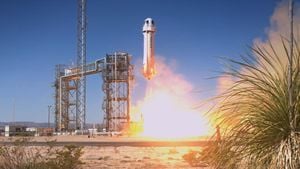Researchers have uncovered startling evidence of volcanic activity on the Moon's far side, thanks to samples collected by China's Chang'e-6 mission. This remarkable investigation not only sheds light on the Moon's geological history but also unveils the presence of active volcanoes on the lunar surface billions of years ago.
Before Chang'e-6 set foot on the Moon, the far side's unique geology was shrouded in mystery. While scientists had already studied the near side, which faces Earth, the far side remained largely unexplored. Historically known as the "dark side" of the Moon (a misnomer, as it receives just as much sunlight), the far side is fraught with intriguing geological features.
During the mission, which returned lunar material to Earth, researchers analyzed basalt fragments from the lunar soil and found some dating back over 4.2 billion years. These findings have been detailed in prestigious journals like Nature and Science.
"This is incredibly exciting research for the lunar science community," said Professor Qiuli Li from the Institute of Geology and Geophysics at the Chinese Academy of Sciences. He explained how the study’s revelations are key to unlocking the long-standing question of the Moon's hemispheric dichotomy—a difference noticed by scientists in terms of basalt distribution, crustal thickness, and other chemical elements. According to Li, findings like this are invaluable for future planetary sciences.
While the nearside of the Moon is characterized by vast dark plains known as maria formed from ancient volcanic activity, the far side is primarily covered with craters and possesses very few such plains. The change starkly displays the Moon's geological diversity. This leads scientists to question why these differences exist.
The sample analysis showed two significant volcanic events. The first, dating to approximately 2.8 billion years ago, indicates local volcanic activity likely related to the Chang'e-6 landing site. Interestingly, no such eruptions have been documented on the nearside, adding weight to the theory of the Moon's diverse geological history.
Postdoctoral researcher Zhang Qian, also involved in the study, led systematic radioisotope dating first on 108 basalt fragments recovered from Chang'e-6. Out of these, 107 showed formation ages of about 2,807 ± 3 million years, confirming they originated from local eruptions. The oldest fragment, before the local ones, dates back to 4,203 ± 4 million years, marking it as the oldest lunar basalt sample ever retrieved.
The investigation provides insights not only about the ages of these basalt samples but also about their origins. By evaluating the geochemical compositions, researchers believe there could be distinct mantle sources linked to younger volcanic activity compared to older samples.
Major changes happened on the Moon during its early history, marking periods of intense volcanic activity. Initially, the Moon's surface was constantly bombarded with ejecta from meteoroids and asteroids, with lava projections from volcanic eruptions. Yet, we now know assertively through this research, powered by the Chang'e-6 mission, volcanic activity extended over what we see today for at least 1.4 billion years.
This comprehensive analysis has prompted researchers to revisit previously established lunar models. For tens of years, the scientific community has hypothesized about the processes responsible for the Moon's surface differences, but this newfound data suggests they were long-lasting—and primarily driven by volcanism events.
"Understanding these volcanic periods is quintessential for filling gaps about the evolution of the Moon as well as how its hemispheric features came to be," remarked Professor Yi-Gang Xu from the Guangzhou Institute of Geochemistry, sharing his perspective on findings from Chang'e-6.
Further studies are likely to focus on correlational research between the nearside and far side data using Chang'e-6 results. This could provide more entries for cross-referencing volcanic and event histories, helping scientists assemble pieces of the Moon's past stories.
Taken together, the findings highlight the importance of the Chang'e-6 mission, which stands as the first-ever successful retrieval of samples from the far side of the Moon. This undertaking establishes China at the forefront of lunar exploration.
Moving forward, as various international entities express interest in lunar missions, Chang'e-6's findings undoubtedly will play not only as historical references for lunar volcanism studies but may also influence future missions set to explore the Moon’s surface.



